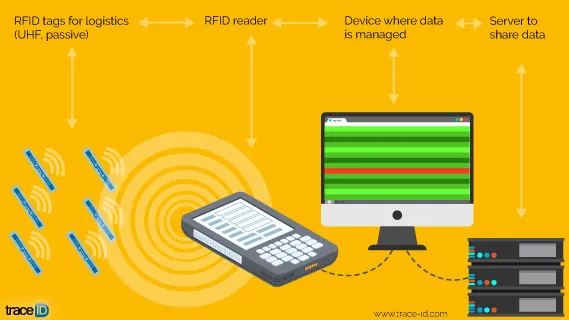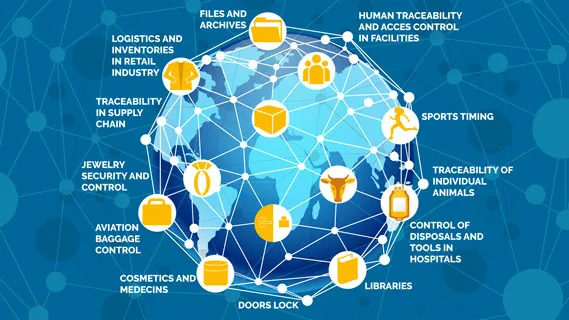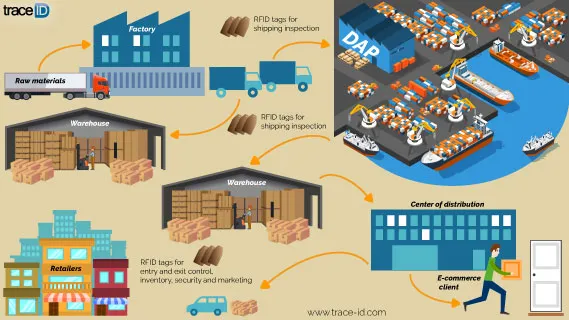Companies with RFID logistics show greater competitiveness
The digitization of all processes optimizes the speed, efficiency and profitability of all processes by improving:
- inventory management,
- warehouse,
- transport,
- procurement,
- asset control,
- staffed,
- and exchange with suppliers.
As well as the realization and management of metrics to analyze and execute continuous improvement strategies. The system that makes this leap to the digitization of all processes possible is RFID logistics.
What is RFID logistics
In a very short way, we will define that RFID systems and solutions allow us to identify an object with a unique code for its exact real-time traceability, being able to read these codes en masse and without direct line of sight at different distances, which can range from the contact to the 10cm (RFID HF), to the 12m (of the UHF RFID with passive tags), up to 30m (UHF RFID with active tags).
The update of logs in databases in real-time, at the same time, that the event happens. RFID technology also allows to automate logistics processes without human intervention, update the data and share it within the system and with external partners at high speed and with total precision.

The application of RFID technology for logistics
In Spain, 52% of RFID tags consumed are used for RFID systems in logistics.1 The rest is applied in access control, in control of machinery and consumables of the health industry and also in hospitality, in product safety in retail businesses, in sports and production timing, or in the improvement of the end customer experience, among others. In addition, RFID tags can meet various traceability, security and marketing needs. At Trace ID, as manufacturers of RFID tags, we have a turnover of selling RFID tags for logistics of 50%, covering the rest of the activities of companies the other 50% of the production of RFID tags.

Logistics has not been alien to the digital transformation that has redefined our society over the past two decades, from people to organizations. In some ways, the change has been generated as defensive and adaptive strategies to changes in consumer behaviour, changes in international communications or changes in manufacturing processes. However, it has ended up being revealed as a powerful opportunity generator. Opportunities for greater efficiency and also of greater profits, both implying greater competitiveness of the company. A key case as an example is e-commerce.
Faced with the huge increase in transactions in the digital age, logistics has faced the challenge by becoming faster, safer, more reliable, more flexible, and also more profitable. These changes have been made possible to the adoption of new technologies and systems such as RFID, BlockChain, Big Data, CRM and ERP.

Proofs of the increased company’s competitiveness thanks to logistics with RFID
- Inventory knowledge accuracy improves by 25.4% with the implementation of an RFID system.2
- Stock breakage decreases from 16.5% to 9.8%, which means a 40.6% improvement with the increase in sales and opportunities that this2
- In relation to unknown loss,3 the success story of the application of RFID technology in Zara is very enlightening. The unknown loss can reach 0.8% of the product in a company like Inditex, which means an economic loss of up to 100 million euros.4 Instead, an RFID system allows you to control in detail the unknown loss resulting in huge savings.
- Grupo Éxito, leaders in the retail sector in Latin America, reported that the cost of inventory management was reduced by 93% thanks to the implementation of an RFID5
- The same group also reported that the declines were reduced by 60%.5
According to the National Statistical Institute (INE), the percentage of companies that make use of RFID technology for product identification after the production process in Spain,6 reaches 22.58%, and this change has occurred in recent years. So we can predict that the RFID app still has a lot of travel ahead of it.
The highlights
For Manufacturers
- Better customer service
- Process optimization
- Faster billing
- Streamlining boarding documents
- Automation
For Distributors
- High shipping accuracy
- Faster and more reliable deliveries
- Better traceability of products and processes
- Higher cost savings
For retailers
- Processes are faster
- Fewer stockouts
- Cost savings
- Better customer service
- Security
Competitiveness and profitability
This article summarized the impact of RFID technology on the competitiveness of companies. But how to calculate your profitability is more complicated. At Trace ID, as manufacturers of RFID tags, we have first-hand knowledge of the RFID technology market and how a company’s competitiveness improves with the implementation of an RFID system in its processes. However, call the profitability of the implementation of RFID technology has the difficulty of quantifying predictive variables such as how many sales do I lose from stock breakage?, how much money I waste on products that will not come out of the store? and also economically quantify improvements such as speed, higher efficiency, accuracy, flexibility, etc. While the application of RFID in the company needs a significant initial investment, experience tells us that the amortization of this initial investment is soon satisfied because the benefits grow exponentially and cover over that investment and spending on RFID consumables, that is, RFID tags and hardware renewals.
Improve the efficiency and safety of your processes and goods thanks to an RFID system
1.- Source: J. Algara, L. Blanco y A. Castillo, RFID technology applied to transport and logistics,2010, EOI Executive MBA.
2.- Source: Kurt Salmon, RFID in Retail Survey,2016, Accenture.
3.- Unknown loss: theft, supplier fraud, internal and external errors, stock breaks.
4.- Source: Claudia Mirror Repiso, Study of the applications of RFID technology and their degree of implementation,2018.
5.- Source: zonalogistica.com, Implementation of RFID technology in Successful Group.
6.- Source: National Institute of Statistics, Survey of ICT Use and E-Commerce in Companies, 2017.
7.- All illustrations are made by own from modified vectors of freepick.com.
8.- Main fot by Michal Parzuchowski on Unsplash.
Contact us for more information focused on your needs. If you wish to receive information about RFID technology, subscribe to our magazine.






